|
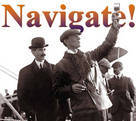
 Up
Up 
 The Last Piece
The Last Piece
of the Puzzle

(You are here.)



  Need
to Need
to
find your
bearings?
Try
these
navigation aids:
If
this is your first
visit, please stop by:
Something
to share?
Please:



|
|
 t
had seemed simple enough. The Wright brothers had based their initial
plan on a fact of nature that most of us discover as children. Stick
your hand out the window of a moving car and bend it at the wrist to
catch the wind. The air pushes your hand up. Bend it the other way and
the air pushes your hand down. t
had seemed simple enough. The Wright brothers had based their initial
plan on a fact of nature that most of us discover as children. Stick
your hand out the window of a moving car and bend it at the wrist to
catch the wind. The air pushes your hand up. Bend it the other way and
the air pushes your hand down.
Air exerts a force
as it flows past a surface; change the angle of that surface in the
airstream and it changes the force – this is basic aerodynamics. Find
the right combination of movable surfaces and you can balance an
airplane in flight – this is aerodynamic control. Working from that
simple premise, the Wright brothers set out in 1899 to create an
effective aerodynamic control system for a flying machine.
They had modeled
their control system after birds. Their horizontal rudder – what we now
call an elevator – pitched the nose of their gliders up and down, doing
the same job as a bird’s tail feathers. An ingenious system of pulleys
and wires twisted or “warped” the glider wings, increasing the angle at
which the wing met the airstream on one side of the aircraft and
decreasing it on the other. This performed the same function as the
flexible wings of a bird, rolling the glider right or left. Pitch and
roll control should have been all that was needed to balance the glider
and keep it pointed straight ahead. After all, this was all that a bird
seemed to need.
But it wasn’t that
simple. The Wrights’ first two years had been occupied finding a wing
shape and size that would keep them aloft for more than a few seconds.
They built two gliders that didn’t live up to expectations, then – to
avoid a third disappointment – did painstaking wind tunnel research on
lift and drag, the forces generated when air moves over a wing. It paid
off. They used the wind tunnel results to design their third glider and
when they tested it at Kitty Hawk in 1902, it generated sufficient lift
for them to make long glides. And it was during these longer flights
that they finally had enough time to thoroughly test their
roll-and-pitch control system.
There were
problems. Their simple system of movable surfaces produced unanticipated
and confounding results.
They had some
indication of these problems the year before when flying their second
glider, even though it was a poor flyer. When in the air, the nose
seemed to hunt and the 1901 glider wandered of course. The problem got
worse when they warped the wings. Pitch control had worked fine, but
roll control was dicey. When a wing dipped to one side, Wilbur – who was
doing all the flying at this point – would kick the T-bar at the back of
the glider. This in turn twisted the wings, increasing the angle at
which they met the wind on the low side and reducing the angle on the
high side.
The aircraft would
begin to roll and the low wing would rise, as the brothers figured it
would. But then the nose begun to hunt – the technical term was yaw
– toward the low wing. Occasionally the low wing would simply stop
flying; the glider would drop toward the stalled wing and smash into the
sand. Will and Orv invented a term to describe this phenomena. When they
had set up camp at the base of Kill Devil Hills in 1901, they had sunk a
well by hammering pipe into the soft, sandy ground. The suddenness and
ferocity with which the glider hammered itself into the sand reminded
them of this, so they called it “well-digging.”
Will had added a
fixed tail to the 1902 glider in hopes of avoiding this well-digging.
There were two vertical panels of cotton muslin mounted on outriggers
sticking out behind the wings. The panels did not move; they were not
part of the control system other than Will hoped their presence would
keep the nose of the glider pointed straight ahead. They did not. When a
wing dipped and Will or Orv – both the brothers were flying now – warped
the wings to balance the glider, the nose turned toward the low wing.
The Wright brothers
were not trying to turn the glider in the air, not at this point in
their carefully thought-out test flights. They made slight S-turns to
test the effectiveness of the wing-warping controls, but otherwise their
intention was to keep the nose pointed directly into the wind. The
purpose of the roll control was to keep the wings level and make small
corrections if the glider wandered off course. In a turn, a pilot
purposefully drops a wing in the direction he wants to turn the
aircraft. The aircraft swings in an arc around the low wing. In this
procedure – which the Wrights would not attempt until 1904 – the pilot
drops the wing by decreasing the angle at which the wing meets
the wind (the angle of attack).
The maneuver that
was giving the Wrights fits was just the opposite of a turn; it was what
pilots do to stop a turn. A gust of wind or some other vaguery of
the atmosphere would cause a wing to drop. If left in this position, the
glider would begin an unintentional turn and in a few moments would no
longer be flying into the wind. Furthermore, if the pilot attempted to
land in this attitude, the low wing would catch the sand and the glider
would cartwheel. To avoid these problems the pilot had to raise the low
wing and return to level flight. He did so by increasing the
angle of attack on the low wing. The nose of the glider was yawing
toward the wing with the highest angle of attack.
On the evening of
October 3, 1902, Orville could not get to sleep and decided instead to
mentally walk himself through the yaw problem. Orville had helped his
brother with the wind tunnel experiments; in fact he had designed the
balances that precisely measured lift and drag. He had an intimate
understanding of the forces in play on a flying wing and could easily
paint a mental picture of them. |
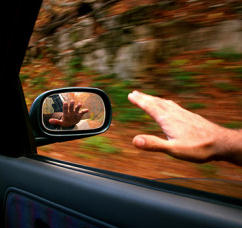
An experiment in aerodynamic control.
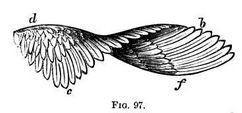
As part of their control system, the Wright brothers twisted or "warped"
the wings of their gliders similar to way birds seemed to move their
wings. This illustration is from James Bell Pettigrew's
Animal Locomotion, one of the
books Wilbur studied in preparation for the Wrights' gliding
experiments.
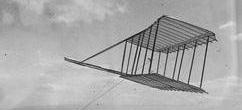
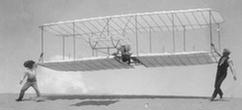
Neither the 1900 Wright glider (top) or the 1901 glider (bottom)
produced the predicted amount of lift.
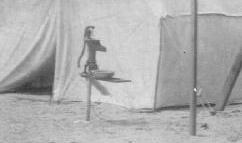
The Wrights' well at Kitty Hawk –
it was not dug in the traditional sense; the pipe was hammered into the
sand.
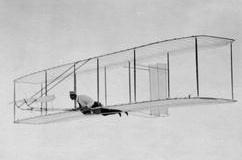
Initially, the 1902 Wright glider had a fixed tail
– the
vertical panels did not move.
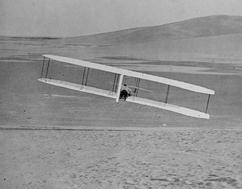
This photo is
often misrepresented as Orville making a right turn. Actually, Orville
is attempting to return to level flight. The right wing has dipped and
Orville has moved his hips to the left, warping the wings and increasing
the angle of attack on the right
|
|
Imagine the
glider as if it were balanced on the point of a pin as it
traveled through the air. Just as it moves in three dimensions,
it rotates around three axes that pass through the pinpoint. It
pitches nose up and nose down around the lateral axis
(red) and rolls one wing up and the other down around the
longitudinal axis (blue). Finally it yaws nose right and
nose left around the vertical axis (green). The Wrights’ initial
control system – elevator and wing-warping – balanced the glider
in pitch and roll. They had hoped to stabilize the yawing with
the addition of a fixed tail, but it wasn’t working. |
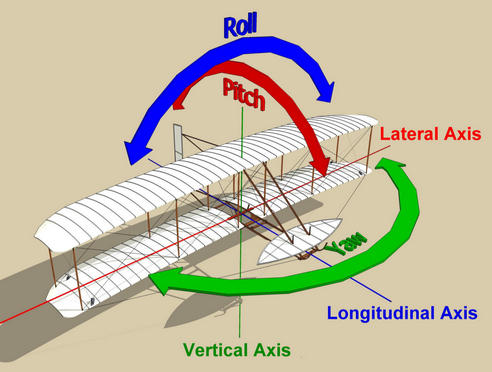
|
Now add the
forces in play. When an airstream (represented by the blue
arrows) moves over and under a wing, it generates lift (green
arrows). When the wing is straight – not warped or twisted – it
meets the airstream at the same angle of attack all along its
length. The lift generated by the airstream is equal all along
the wing. The wing is balanced around its longitudinal axis and
has no tendency to roll.
|
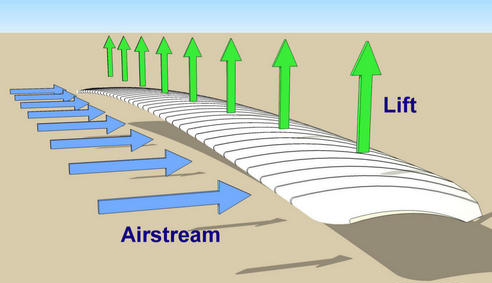
|
In addition
to lift, the air moving over and under the wing also generates
drag (red arrows), a force that impedes the travel of the wing
through the air. Like lift, the drag is uniform all along the
length of the straight wing. The wing is balanced around its
vertical axis and has no tendency to yaw.
|
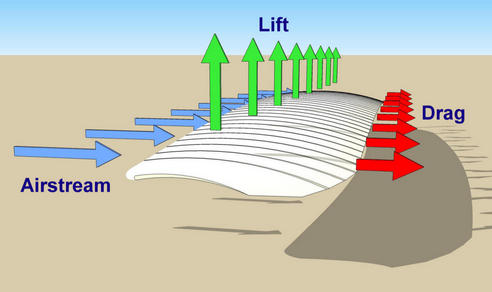
|
The Wright
brothers’ control system twisted the wings around their lateral
axis. As the wings were warped, the angle of attack increased at
one wing tip and decreased at the opposite wing tip.
|
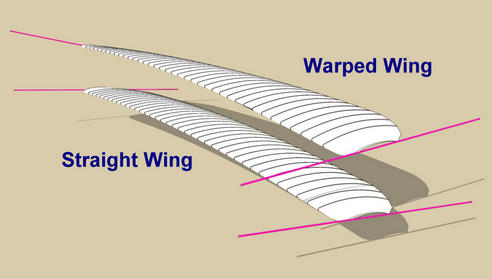
|
When warped,
a flying wing no longer produces uniform lift along its span. In
general, as the angle of attack increases, so did the amount of
lift. On those sections where the airstream blows directly on
the top surface, it might even produce negative lift
(dark green arrows), pressing down on that part of the wing.
With more lift on one side of the longitudinal axis that on the
other, the wing wants to roll (yellow arrow).
|
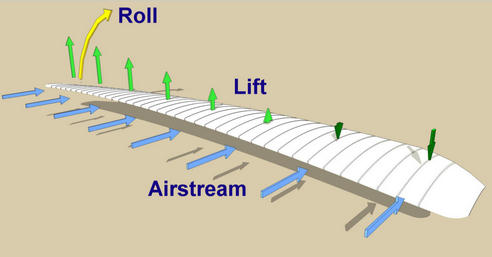
|
The angle of
attack also affects drag. In general, as the angle decreases, so
does the drag. On those wing sections where the angle goes
negative and the wind is pressing on the top surface, the drag
will begin to rise again. But on the average, there is more drag
on the side where the angle of attack is highest. This in turn
will cause the wing to yaw (orange arrow). This is what was
making the nose of the glider to hunt toward the low wing!
If the glider was close to it’s minimum flying speed, producing
just enough lift to stay airborne, the sudden yaw would cause
one side of the wing to speed up in the airstream while the
other slowed and stalled – stopped flying. The glider
would drop toward the stalled portion of the wing and ka-bam!
Well-digging.
|
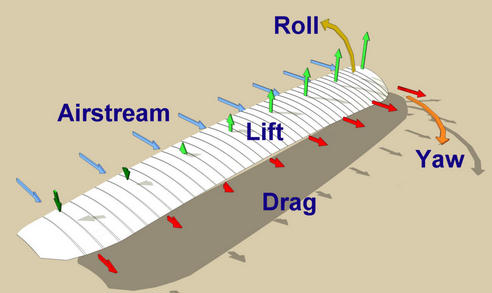
|
Orville
reasoned that this tendency – now called adverse yaw –
could be countered by modifying the tail and incorporating it in
the control system. Convert the fixed tail to a movable rudder
and turn it in the airstream toward the side of the wing that
was producing the least amount of drag.
|
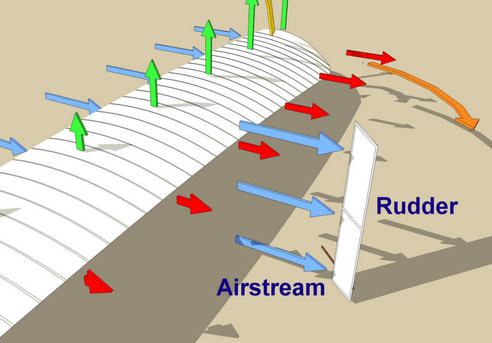
|
The
airstream would press against the rudder surface creating a
force that, when added to the unequal drag, opposed and stopped
the tendency to yaw, restoring balance around the vertical axis.
The aircraft would still roll around the longitudinal axis
–
there was no opposing force to stop it
–
but it would do so while traveling straight ahead with no
tendency to wander off course.
|
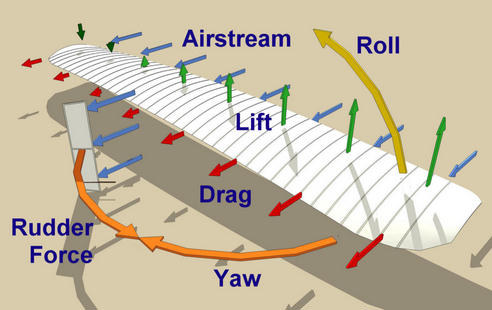
|
|
|
Before breakfast
the next morning, Orville called
Lorin aside. Lorin, who had decided that his brothers Will and Orv
were having way too much fun in Kitty Hawk, had traveled from Dayton for
a short visit. Orv confided to Lorin that he had made a discovery during
the night and he predicted what would happen next. When Orv told Will
about adverse yaw and how to counter it, said Orv, Will would
immediately shift into his big-brother mode and get all lofty and
condescending. Orv warned Lorin that Will would probably brush his
discovery aside, Orv would defend it, and this would likely be the beginning
of one of their classic arguments, arriving at the truth only after Will
and Orv had screamed and shouted at one another for hours.
At breakfast, Will
listened carefully to what Orv had to say. This was followed by several
minutes of silence, during which Orv and Lorin waited for the opening
shots in the war of words to come. But nothing happened. Wilbur
apparently knew an epiphany when he heard one. He quietly agreed with
Orville, and then surprised him by proposing a further modification.
The Wrights had
dispensed with the awkward T-bar used in previous gliders to warp the
wings and were now using a cradle they moved with their hips.
Wilbur suggested to
Orville that they should tie the rudder control into the hip cradle. At this point in their test flights, the rudder was needed to counteract
adverse yaw only when the wings were warped. It made sense to tie these
two controls together –
less work for the pilot.
Over the next few
days, the Wrights converted the double-surface fixed tail to a
single-surface rudder. They first flew the glider with a rudder on
8 October 1902, and were rewarded by the results. It would need tweaking,
but the rudder plainly countered the dangerous yawing. Later, this
three-axis control system – pitch, roll, yaw – would become the basis
for their patent.
Much later, it would
be recognized as a milestone in the history of technology. The 1902
Wright Glider was the first flying machine to have three-axis
aerodynamic controls. In 1914, the Wright patent was adjudicated to be
the “grandfather” patent of the airplane, the beginnings of the
aerospace industry and the jumping off point for an adventure that has
yet to end.Note: For a printer-friendly PDF version of
this page, click HERE.
|
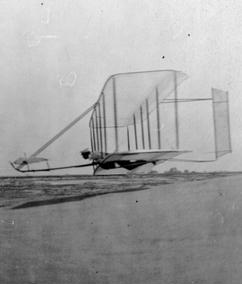
Orville Wright flies the 1902 Wright glider, now equipped with a rudder.
He keeps the aircraft very close to the sand, skillfully following the
slope of the dune. Without effective roll control, this maneuver would
have been dangerous – the pilot
would have risked sticking a wing in the sand. The Wrights' brother
Lorin, who had come to Kitty Hawk to visit Will and Orv, probably
snapped this picture.
|
|
|
|